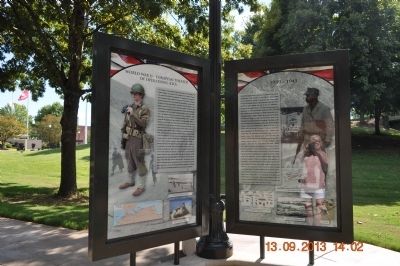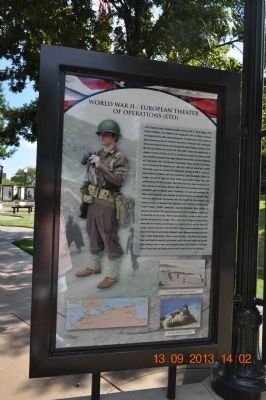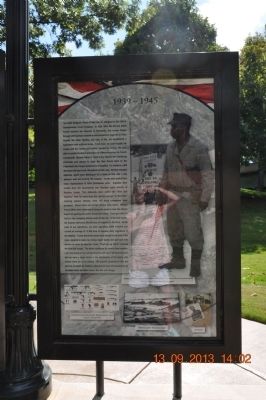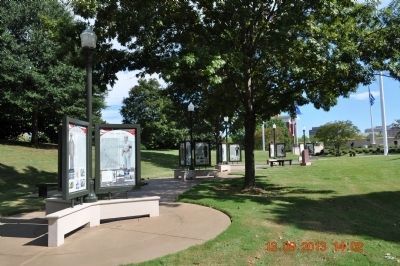Huntsville in Madison County, Alabama — The American South (East South Central)
World War II - European Theater of Operations (ETO)
1939-1945
Inscription.
I am Corporal Leroy Hoekenschnieder serving with D “Dog” Battery, 5th Artillery Battalion. Our battalion was assigned to the 1st Infantry Division and support the 26th Infantry Regiment. The Depression had caused my dad’s business to fail so I enlisted in the Army. In 1940 and 1941, we Regular Army units trained, but we never thought the United States would go to war. Me and my buddies who joined the Army didn’t realize the significance of Japan’s invasion of China in 1937 or Germany’s invasion of Poland in 1939. But, everything changed when Japan attacked Pearl Harbor and the Philippines on 7 December 1941. Our Division Commander, Major General Terry Allen, told us we would be shipped out. Little did I think we would go to North Africa! We made the second US amphibious landing of WW II. I was surprised that the landing craft were crewed by Coast Guardsmen. When we landed, we had to fight the Vichy French government troops who were collaborating with the Germans. The French had once been our ally, so we were told not to fire unless fired on. Well, the French quickly removed that prohibition and we blasted away! Thankfully, our new semi-automatic M1 rifles, called Garands, were superior to both the French and German rifles. From our beachhead, we pushed east and fought the elite armored and infantry troops of German Field Marshall
Edwin Rommel’s Afrika Corps. These mobile combat operations required American field artillery to develop new tactics. We responded quickly to calls for artillery support and to mass fire on the enemy. With motorized artillery, we were able to move quickly and always be in range of the troops. As a Forward Observer (FO), I went with the infantry and directed my battery’s fire to aid the front line troops. Good as we were, when the Afrika Corps counter-attacked us in the Kasserine Pass we were badly whipped! I was captured and spent over two years in Nazi POW camps. That is a story for later. Like Americans always have we licked our wounds, got smarter, and in the next battles we showed them a thing or two. In fact, we eventually kicked the Germans out of North Africa, Sicily, Italy and finally pushed them across France into Germany.
1939-1945
I am Staff Sergeant Homer H. McCraw, Sr. assigned to the 3393rd Quartermaster Truck Company. In June 1944, the US and Allied Forces stormed the beaches of Normandy. Our troops fought through stiff German resistance and sustained a huge toll of lives. Despite the bitter fighting and loss of life, we established a beachhead with artificial docks. From here, we could supply the troops with the “beans and bullets” needed for victory. We were able to quickly breakout and begin our offensive across the French countryside.
General Patton’s Third Army cleared the Cherbourg Peninsula and started to push the Nazi forces back to the Fatherland. Our troops needed tons of supplies. For instance, a M4 Sherman tank used over 140 gallons of fuel a day. Normal resupply methods, which were developed for a three to five mile a day advance, were not working. We adapted. Trucks were pulled from many organizations to form provisional units. Supplies were rushed from the beachheads and liberated ports directly to frontline troops. This elaborate plan, called the “Red Ball Express,” took its name from the railroad phrase “to Red Ball” meaning express delivery. Over 140 trucks companies were assigned. About three out of four drivers were black. Military Police (MPs) were stationed all along the route to help the drivers keep from getting lost and to secure the routes. Convoys rolled 24 hours a day swapping drivers even on the run. In the first month, the Express delivered 290,000 tons of supplies to the front. At the peak of our operations, we were operating 6,000 vehicles and carried an average of 12,500 tons of supplies daily regardless of the weather. Trucks that broke down were shoved to the side of the road, repaired in place by roving repair teams and put back into service as soon as possible. Soon, “Push’em up there!” became the Red Ball slogan. The effort continued for nearly
three months. I am very proud of my unit and my men who gave all they had and I feel we were a major factor in the destruction of the Nazis, who looked down on us as inferior. We proved ourselves in this war and are accepted as soldiers, although we may not necessarily be accepted when we return home. But this will change.
Erected 2013.
Topics. This memorial is listed in this topic list: War, World II. A significant historical month for this entry is June 1944.
Location. 34° 44.11′ N, 86° 35.322′ W. Marker is in Huntsville, Alabama, in Madison County. Memorial can be reached from the intersection of Monroe Street Northwest and Monroe Street Northwest, on the left when traveling east. Located along Patriots Walkway in Veterans Park. Touch for map. Marker is at or near this postal address: 200 Monroe St NW, Huntsville AL 35801, United States of America. Touch for directions.
Other nearby markers. At least 8 other markers are within walking distance of this marker. ETO 1939-1945/PTO 1941-1945 (here, next to this marker); Korean War/1950-1953 (here, next to this marker); Cold War-Global 1945-/ Cold War-Germany 1945-1990 (here, next to this marker); Gulf War-1991/War on Terrorism (here, next to this marker); 1959-1975/Vietnam War/Vietnam War (here, next to this marker); Korean War / Cold War-Korea 1953- (here, next to this marker); World War II - Pacific Theater of Operations (PTO) (here, next to this marker); World War I (Great War)/1914 – 1918 (a few steps from this marker). Touch for a list and map of all markers in Huntsville.
Credits. This page was last revised on June 16, 2016. It was originally submitted on January 26, 2014, by Sandra Hughes Tidwell of Killen, Alabama, USA. This page has been viewed 984 times since then and 42 times this year. Last updated on July 20, 2015, by J. Makali Bruton of Accra, Ghana. Photos: 1, 2, 3, 4. submitted on January 26, 2014, by Sandra Hughes Tidwell of Killen, Alabama, USA. • Bernard Fisher was the editor who published this page.



